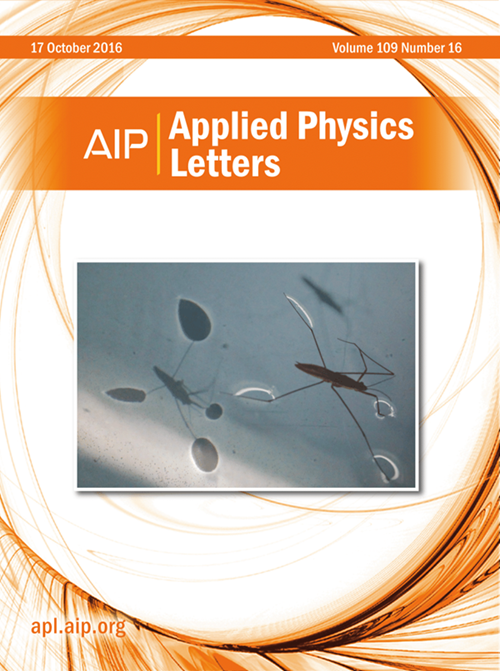Anatomy of internal electric field profile in operating SiC power MOSFETs with local contact potential probing
IF 3.5
2区 物理与天体物理
Q2 PHYSICS, APPLIED
引用次数: 0
Abstract
A comprehensive understanding of local contact potential profiles and carrier transport mechanisms in SiC MOSFETs is crucial for optimizing device design and performance. We report the evolution of local contact potential across the cross section of 1200 V SiC MOSFETs under applied external bias using Kelvin probe force microscopy. In the vertical direction of the cross section, notable features in the relative contact potential difference (RCPD) are identified at the interfaces of the P well and N− drift layer, as well as between the N− drift layer and the N+ substrate. The RCPD drop-out values at the P well to N− drift layer interface increase from 0.17 to 1.54 V and then to 2.94 V as the external voltage is adjusted, with corresponding values of 2.43 and 3.86 V observed at VGS = VDS of 2 and 4 V, respectively. Conversely, the RCPD drop values at the N− drift layer to N+ substrate interface fluctuate between −0.38 and 0.74 V. In the horizontal direction of the cross section, as VGS = VDS increases from 0 to 4 V, the RCPD drop-out values change from 0.14 to 1.33 V, and ultimately reach 2.41 V. These variations are indicative of enhanced energy band bending at the P–N junction due to charge injection, revealing key insights into the electric field distribution within the device. This study elucidates the local contact potential profile evolution in SiC MOSFETs and highlights intrinsic electrical properties essential for advancing SiC-based power devices.局部接触电位探测工作SiC功率mosfet内部电场分布的解剖
全面了解SiC mosfet中的局部接触电位分布和载流子输运机制对于优化器件设计和性能至关重要。我们使用开尔文探针力显微镜报道了在外加偏压作用下1200 V SiC mosfet横截面局部接触电位的演变。在垂直截面上,P井与N -漂移层交界面以及N -漂移层与N+衬底之间的相对接触电位差(RCPD)特征显著。随着外部电压的调整,P阱与N -漂移层界面处的RCPD drop-out值从0.17增加到1.54 V,再增加到2.94 V, VGS = VDS为2 V和4 V时的RCPD drop-out值分别为2.43和3.86 V。相反,N -漂移层到N+衬底界面的RCPD下降值在- 0.38和0.74 V之间波动。在横截面水平方向上,随着VGS = VDS从0增大到4 V, RCPD dropout值从0.14增大到1.33 V,最终达到2.41 V。这些变化表明,由于电荷注入,P-N结的能带弯曲增强,揭示了器件内电场分布的关键见解。本研究阐明了SiC mosfet中局部接触电位分布的演变,并强调了推进SiC基功率器件所必需的内在电学特性。
本文章由计算机程序翻译,如有差异,请以英文原文为准。
求助全文
约1分钟内获得全文
求助全文
来源期刊

Applied Physics Letters
物理-物理:应用
CiteScore
6.40
自引率
10.00%
发文量
1821
审稿时长
1.6 months
期刊介绍:
Applied Physics Letters (APL) features concise, up-to-date reports on significant new findings in applied physics. Emphasizing rapid dissemination of key data and new physical insights, APL offers prompt publication of new experimental and theoretical papers reporting applications of physics phenomena to all branches of science, engineering, and modern technology.
In addition to regular articles, the journal also publishes invited Fast Track, Perspectives, and in-depth Editorials which report on cutting-edge areas in applied physics.
APL Perspectives are forward-looking invited letters which highlight recent developments or discoveries. Emphasis is placed on very recent developments, potentially disruptive technologies, open questions and possible solutions. They also include a mini-roadmap detailing where the community should direct efforts in order for the phenomena to be viable for application and the challenges associated with meeting that performance threshold. Perspectives are characterized by personal viewpoints and opinions of recognized experts in the field.
Fast Track articles are invited original research articles that report results that are particularly novel and important or provide a significant advancement in an emerging field. Because of the urgency and scientific importance of the work, the peer review process is accelerated. If, during the review process, it becomes apparent that the paper does not meet the Fast Track criterion, it is returned to a normal track.
 求助内容:
求助内容: 应助结果提醒方式:
应助结果提醒方式:


